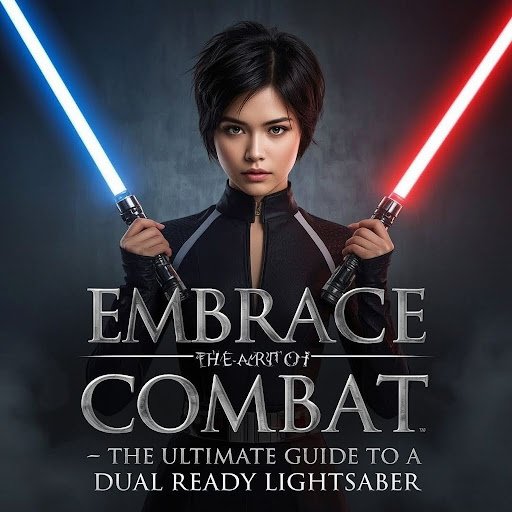Introduction: A Weapon for the Bold
In the vast Star Wars galaxy, lightsabers aren’t just weapons, they are symbols of power, discipline, and identity. Among the many forms and fighting styles, the Dual Ready Lightsaber stands out as one of the most versatile and aggressive choices for Force users. Designed for both single-handed use and quick transformation into a double-bladed saber, this type of lightsaber offers the flexibility of two fighting styles in one hilt.
Whether you’re a fan of Darth Maul’s furious double-bladed onslaught or Ahsoka Tano’s swift dual-wielding combat style, a dual ready saber puts you in control of the battlefield. It’s more than just a functional design, it’s a reflection of adaptability, creativity, and strategy.
This in-depth guide covers the philosophy, design, customization options, and combat advantages of a dual ready lightsaber a must-have weapon for any Jedi or Sith who craves control and versatility.
What Is a Dual Ready Lightsaber?
A Dual Ready Lightsaber is a lightsaber built with modular hilts that can be used individually or connected together to form a double-bladed saber. It typically features:
- Two individual hilts that are combat-capable on their own
- Connector coupler that allows both hilts to become a single staff saber
- Symmetrical or mirrored design for balanced dual wielding
- High durability for intense dueling sessions
This type of saber is designed for fighters who demand options — whether switching styles mid-combat or adjusting to different opponents. It’s a favorite for those who practice Form IV (Ataru) or Form VI (Niman), where fluid motion and improvisation are key.
The Inspiration Behind Dual Ready Sabers
Throughout Star Wars history, various Force users have showcased the power of dual sabers or double-bladed combat:
- Darth Maul – Mastered the double-bladed lightsaber, using ferocity and agility to overwhelm enemies
- Ahsoka Tano – Dual wielded a standard saber and a shoto, showcasing precision and coordination
- Asajj Ventress – Wielded two red curved-hilt sabers and occasionally linked them into a double blade
- Pong Krell – Used two double-bladed sabers simultaneously, emphasizing the advantage of versatility
The dual ready saber allows you to draw from these iconic characters and adopt a style that best suits your strengths. One moment, you’re fighting defensively with a single blade. The next, you’re spinning a double-bladed staff with lethal speed.
Key Components of a Dual Ready Lightsaber
A dual ready saber is more than two lightsabers stuck together. It’s a precisely engineered system designed for balance, flow, and transformation.
1. Twin Hilts
Each hilt is fully functional on its own. They’re often symmetrical in design but can also be asymmetrical for a personalized feel. Some users choose:
- Matching hilts for seamless aesthetics
- Contrasting hilts for storytelling (light vs. dark themes)
- One standard hilt, one shoto for dynamic dual wielding
2. Coupler/Connector
The coupler is the most important feature. It locks the hilts together firmly but allows for quick detachment. Options include:
- Static couplers – For permanent staff saber builds
- Quick-release couplers – Allow instant transition during combat
- Rotating couplers – Add flair and spinning options for saber choreography
3. Blades
Both sabers typically use mid-grade or heavy-grade polycarbonate blades. When connected, they must remain stable during spinning and striking. Blade length is critical:
- Dual wielding – Shorter blades (28–32 inches) for control
- Double-bladed staff – Medium blades (32–36 inches) for reach and performance
Some builders also use neopixel blades, providing full lighting effects, multiple color options, and realistic ignitions.
Customizing Your Dual Ready Saber
Customization is a huge part of owning a dual ready lightsaber. Here’s what to consider when designing your perfect setup:
Hilt Design:
- Streamlined hilts for better dual-wield control
- Weathered or ancient styles to reflect heritage or Sith lineage
- Wraps and grip textures for comfort during spins and transitions
Blade Colors:
Choosing your blade color defines your character’s role and philosophy.
- Blue – Represents bravery and combat skill
- Green – Suggests spiritual focus and harmony
- Red – Symbol of raw power and dark side allegiance
- Yellow – Balanced discipline and guardianship
- Purple – Control of both light and dark
- White – Represents independence and clarity
Some fans choose different colors for each blade — representing internal conflict or evolution.
Sound Fonts and Effects:
Dual sabers often come with independent soundboards, allowing for different ignition sounds, hums, and clash effects.
- Flash-on-clash for both blades
- Dual ignition sequences (sequential or simultaneous)
- Blade lockups, blaster deflections, and Force effects
For those using advanced boards like Proffie, it’s possible to program different settings for each hilt.
Fighting Styles with a Dual Ready Saber
Dual ready sabers support several combat styles, depending on configuration:
1. Dual Wielding (Jar’Kai)
This ancient style emphasizes speed and unpredictability. Key traits:
- Independent strikes from each hand
- Defensive parrying with one saber, attacking with the other
- Wide attack angles and rapid combos
Best paired with shorter hilts for agility. Inspired by characters like Ahsoka Tano and Asajj Ventress.
2. Double-Bladed Staff (Saberstaff)
Used famously by Darth Maul, this style focuses on reach, area control, and aggressive movement.
- Spinning attacks that confuse and disarm opponents
- Balanced defense from both ends
- Great for crowd control and multiple enemies
Staff sabers require more room and discipline but can dominate open combat.
3. Hybrid Style Switching
This is where dual ready sabers truly shine. You can:
- Start with a staff saber for aggressive offense
- Disconnect mid-fight to dual wield for precision or deception
- Adapt instantly to the battlefield
This ability is what separates dual ready sabers from any other saber style.
Building Your Own Dual Ready Lightsaber
Creating a dual ready lightsaber can be done through:
Modular Parts System
- Choose compatible hilts and a connector
- Ensure the hilts have similar diameter and threading
- Add matching or custom blades
- Install synchronized or separate soundboards
From Scratch Build
- Customize every component for your preferred weight and grip
- Use internal chassis systems to stabilize electronics
- Paint, weather, or engrave the hilts for a unique finish
This method is time-consuming but results in a one-of-a-kind saber.
Using Dual Ready Sabers in Cosplay, Dueling, and Storytelling
A dual ready saber isn’t just for collecting — it enhances your entire Star Wars experience.
Cosplay:
- Dual wield for dynamic poses and stances
- Build sabers that match your costume or character arc
- Install LEDs to bring your sabers to life on stage or in photos
Dueling:
- Practice switching between staff and dual wield
- Choose blade lengths based on your fighting distance
- Train in Jar’Kai or Form IV for real saber competitions
Storytelling:
- Use different blade colors to represent internal conflict
- Customize sound fonts to reflect your alignment
- Roleplay as a Jedi who fell to the dark side — or a Sith seeking redemption
A dual ready saber lets your story evolve with your combat.
Legacy: The Symbol of Versatility and Mastery
A dual ready lightsaber represents more than strength — it symbolizes transformation. It tells the story of a warrior who refuses to be predictable. A Jedi who learns every form. A Sith who adapts to dominate. A Force user who walks between styles, always prepared for any threat.
In the galaxy far, far away, versatility is survival. And with a dual ready saber in hand, you carry the legacy of some of the most powerful and adaptable warriors the Star Wars universe has ever seen.

